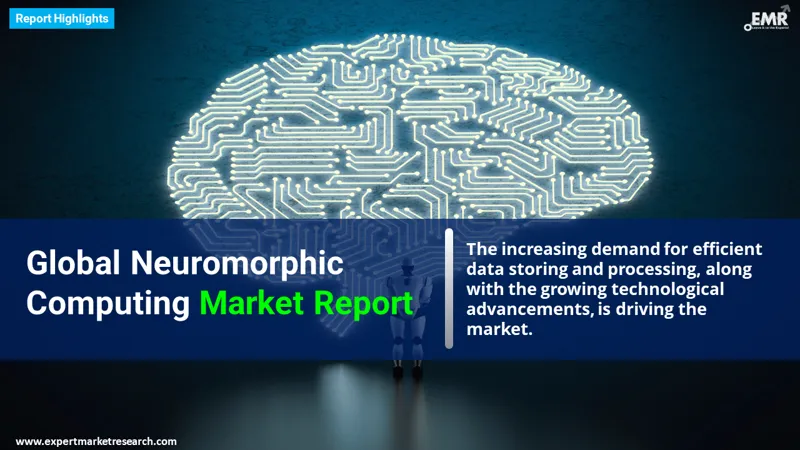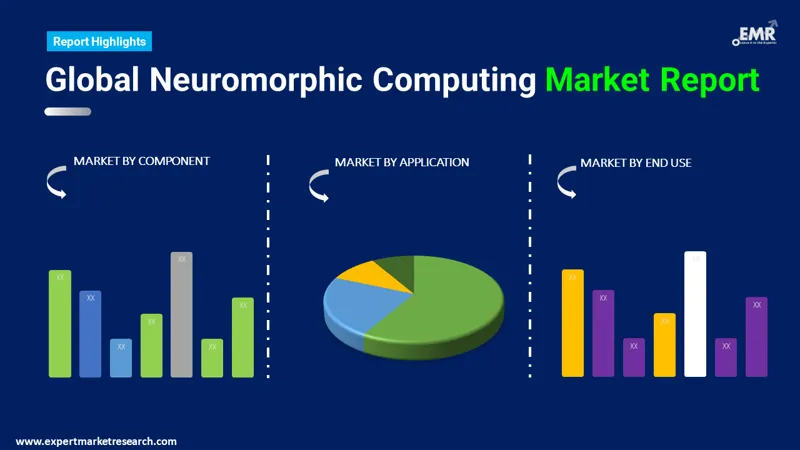
Consumer Insights
Uncover trends and behaviors shaping consumer choices today
Procurement Insights
Optimize your sourcing strategy with key market data
Industry Stats
Stay ahead with the latest trends and market analysis.
The global neuromorphic computing market attained a value of nearly USD 5.52 Billion in 2025. The market is further expected to grow at a CAGR of 20.00% during the forecast period of 2026-2035 to reach a value of USD 34.18 Billion by 2035.
Base Year
Historical Period
Forecast Period
Compound Annual Growth Rate
20%
Value in USD Billion
2026-2035
*this image is indicative*
| Global Neuromorphic Computing Market Report Summary | Description | Value |
| Base Year | USD Billion | 2025 |
| Historical Period | USD Billion | 2019-2025 |
| Forecast Period | USD Billion | 2026-2035 |
| Market Size 2025 | USD Billion | 5.52 |
| Market Size 2035 | USD Billion | 34.18 |
| CAGR 2019-2025 | Percentage | XX% |
| CAGR 2026-2035 | Percentage | 20.00% |
| CAGR 2026-2035 - Market by Region | Asia Pacific | 25.9% |
| CAGR 2026-2035 - Market by Country | China | 24.8% |
| CAGR 2026-2035 - Market by Country | Brazil | 21.9% |
| CAGR 2026-2035 - Market by Component | Hardware | 22.0% |
| CAGR 2026-2035 - Market by Application | Data Processing | 22.8% |
| Market Share by Country 2025 | Saudi Arabia | 1.1% |
The increasing demand for autonomous systems, which are capable of making a suitable decision, is aiding the neuromorphic computing industry. Neuromorphic computing systems need lower power consumption while supporting dynamic learning of complex and unstructured data. Moreover, neuromorphic computing is used to analyse the data produced from climate models, predict maintenance needs for accelerator magnets, and recognising features in large-scale cosmology data. The rising demand for artificial intelligence in nonlinear control and robotics, language processing, image processing, and computer vision, among others, is also contributing to the market growth for neuromorphic computing.

Read more about this report - REQUEST FREE SAMPLE COPY IN PDF
The increasing demand for data and data analytics, miniaturisation of sensors, and cost-effectiveness are further accelerating the market growth. Moreover, neuromorphic computing is increasingly used in the military to collect and process large-sized data efficiently. It is further applicable for the development of cognitive communication system and image processing of unmanned vehicles. Regionally, North America holds the major share of the market for neuromorphic computing owing to the dominant presence of the leading companies and the various initiatives undertaken by them to promote its use in large-scale applications like data centres and server, among others. The Asia Pacific region is expected to witness robust growth due to the rising automated services and increasing technological advancements in countries such as South Korea and Japan, consequently contributing to the overall growth of the market.

Read more about this report - REQUEST FREE SAMPLE COPY IN PDF
Neuromorphic computing, variously known as neuromorphic engineering, is the use of very large scale integration systems containing electronic analogue circuits to model the neuro-biological architects present in the human nervous system. It applies the functionality of a brain to generic cognitive computing and has various advantages, such as energy efficiency and high execution speed.
The major components of neuromorphic computing are:
The market can be broadly categorised on the basis of its applications into:
Based on the end use, the market is divided into:
Market Breakup by Region
| CAGR 2026-2035 - Market by | Country |
| China | 24.8% |
| Brazil | 21.9% |
| Canada | 18.9% |
| Mexico | 18.6% |
| Australia | 17.6% |
| USA | 16.3% |
| UK | XX% |
| Germany | XX% |
| France | XX% |
| Italy | XX% |
| India | XX% |
| Saudi Arabia | XX% |
| Japan | 15.5% |
Various technological advancements such as edge computing and the Internet of things (IoT) are increasingly used in several industries and businesses. With the increasing digitisation, technologies such as drones, smart healthcare, smart cities, and autonomous cars are becoming more prevalent and hence are increasing the demand for neuromorphic computing chips, which can combat the challenge of increasing data and processing. Moreover, increasing research and development (R&D) in the field of both neurology and computing are expected to aid the market growth. The development of neuromorphic chips which functions like a human brain by using artificial neurons is further propelling the market growth. Additionally, neuromorphic computing can create cognitive computing and systems which can reason or learn like a human.
Neuromorphic computing can further improve therapeutic procedures, develop more precise medical imaging, enhance surveillance, improve data mining and pattern recognition systems, and assist in military and security issue which is expected to augment the industry growth in the forecast period. The use of neuromorphic computing in automated vehicles can reduce latency, increase energy costs, and increase the autonomy of the vehicle while improving cybersecurity, consequently lubricating the market growth. The increasing research for neuromorphic computing to improve machine learning, remote sensing, and intelligence analysis is further driving the market. In addition, favourable government schemes and investments are also fuelling the market growth. For example, the U.S. Department of Energy (DOE) announced $2million in funding for five projects in basic research to advance neuromorphic computing in September 2020.
The report presents a detailed analysis of the following key players in the global neuromorphic computing market, looking into their capacity, market shares, and latest developments like capacity expansions, plant turnarounds, and mergers and acquisitions:
The comprehensive report looks into the macro and micro aspects of the industry. The EMR report gives an in-depth insight into the market by providing a SWOT analysis as well as an analysis of Porter’s Five Forces model.




*While we strive to always give you current and accurate information, the numbers depicted on the website are indicative and may differ from the actual numbers in the main report. At Expert Market Research, we aim to bring you the latest insights and trends in the market. Using our analyses and forecasts, stakeholders can understand the market dynamics, navigate challenges, and capitalize on opportunities to make data-driven strategic decisions.*
Get in touch with us for a customized solution tailored to your unique requirements and save upto 35%!
The global neuromorphic computing market is projected to grow at a CAGR of 20.00% between 2026 and 2035.
The market is estimated to witness a healthy growth in the forecast period of 2026-2035 to reach nearly USD 34.18 Billion by 2035.
The major market drivers include the technological advancements and innovations, increasing demand for autonomous systems, the rising deployment of artificial intelligence (AI), and the surging demand for data and data analytics.
The key trends propelling the market demand include the increasing R&D activities in the field of neurology and computing and the growing use of neuromorphic computing in automated vehicles to reduce latency.
The major regions in the neuromorphic computing market are North America, Latin America, the Middle East and Africa, Europe, and the Asia Pacific.
The major components of neuromorphic computing in the market are hardware and software.
The significant applications of neuromorphic computing are signal processing, image processing, data processing, and object detection, among others.
The various end uses of neuromorphic computing are consumer electronics, automotive, healthcare, and military and defence, among others.
The major players in the market are Intel Corporation, BrainChip Holdings Ltd, General Vision Inc., and IBM Corporation, among others.
In 2025, the market reached an approximate value of USD 5.52 Billion.
Explore our key highlights of the report and gain a concise overview of key findings, trends, and actionable insights that will empower your strategic decisions.
| REPORT FEATURES | DETAILS |
| Base Year | 2025 |
| Historical Period | 2019-2025 |
| Forecast Period | 2026-2035 |
| Scope of the Report |
Historical and Forecast Trends, Industry Drivers and Constraints, Historical and Forecast Market Analysis by Segment:
|
| Breakup by Component |
|
| Breakup by Application |
|
| Breakup by End Use |
|
| Breakup by Region |
|
| Market Dynamics |
|
| Competitive Landscape |
|
| Companies Covered |
|
| Report Price and Purchase Option | Explore our purchase options that are best suited to your resources and industry needs. |
| Delivery Format | Delivered as an attached PDF and Excel through email, with an option of receiving an editable PPT, according to the purchase option. |
Single User License
One User
USD 3,999
USD 3,599
tax inclusive*
Datasheet
One User
USD 2,499
USD 2,249
tax inclusive*
Five User License
Five User
USD 4,999
USD 4,249
tax inclusive*
Corporate License
Unlimited Users
USD 5,999
USD 5,099
tax inclusive*
*Please note that the prices mentioned below are starting prices for each bundle type. Kindly contact our team for further details.*
Flash Bundle
Small Business Bundle
Growth Bundle
Enterprise Bundle
*Please note that the prices mentioned below are starting prices for each bundle type. Kindly contact our team for further details.*
Flash Bundle
Number of Reports: 3
20%
tax inclusive*
Small Business Bundle
Number of Reports: 5
25%
tax inclusive*
Growth Bundle
Number of Reports: 8
30%
tax inclusive*
Enterprise Bundle
Number of Reports: 10
35%
tax inclusive*
How To Order

Select License Type
Choose the right license for your needs and access rights.

Click on ‘Buy Now’
Add the report to your cart with one click and proceed to register.

Select Mode of Payment
Choose a payment option for a secure checkout. You will be redirected accordingly.
Gain insights to stay ahead and seize opportunities.

Get insights & trends for a competitive edge.

Track prices with detailed trend reports.

Analyse trade data for supply chain insights.

Leverage cost reports for smart savings

Enhance supply chain with partnerships.

Connect For More Information
Our expert team of analysts will offer full support and resolve any queries regarding the report, before and after the purchase.
Our expert team of analysts will offer full support and resolve any queries regarding the report, before and after the purchase.
We employ meticulous research methods, blending advanced analytics and expert insights to deliver accurate, actionable industry intelligence, staying ahead of competitors.
Our skilled analysts offer unparalleled competitive advantage with detailed insights on current and emerging markets, ensuring your strategic edge.
We offer an in-depth yet simplified presentation of industry insights and analysis to meet your specific requirements effectively.
Share